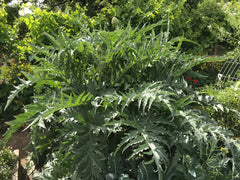Growing Globe Artichokes in Your Backyard
Posted May 11, 2022 in

Globe artichokes are easily raised from a transplant. It’s easier and quicker to grow from an already started plant than it is from a seed. Although seeds give you more options of varieties than you find in most nurseries. Plants should last for at least three or four years before they begin to tire themselves and become candidates for dividing or propagating.
Grow globe artichokes in a sunny, sheltered spot with fertile soil and slightly acidic soil. The best time to plant starts out is March through May. The colder your climate, the later in the season you should plant. We are in a zone 8 and March is a perfect time for us.
Artichoke plants can get very large, so allow enough room for them to grow. 6 foot spacing is best. I usually place mine on the end of a garden row so not to take the space in the middle. It will reach out its leaves into the beds nearby.
When preparing the soil, add plenty of compost and work deeply. Plant at soil level as it came in its pot. If your soil pH is already low, then use a Starter Mix 3-3-3 fertilizer at planting time. Lowering your soils pH for those who have alkaline soils can simply be done with using Acid Mix Fertilizer 4-3-6 twice per year. Feed once in March and again 6 weeks later.
In a new plants first year, cut off its main flower head as soon as it appears. If allowed to produce the first year, the plant will suffer and not get a good root system to live through the winter. In the fall, feed phosphorus to encourage more root growth, such as Rock Phosplate 0-3-0. Cut out any dead foliage and cover with leaves, mulch or straw to protect the crown and roots.
Artichoke plants can produce up to 20-30 globes if happy. Cut the globes when they begin to fatten up, but before its scales begin to open. You will know what to look for once you see them develop and begin to open. I always leave the later, smaller globes towards the end of the harvest to flower. The flowers are amazingly beautiful and the bumble bees LOVE them! Once they are done flowering the plant begins to look wore out. Cut or saw out the large stocks that the globes grow on as low as you can without going into the main base of the plant and remove dead foliage to clean up the plant. It will look so much smaller than the spring, but it is necessary to remove those stocks so the plant will stop putting its energy into that large stock that is no longer needed.
There are a few pest that can cause havoc on the plants. Slug and snails like to live in the base of the plants and earwigs will crawl into the globes themselves and leave something NOBODY wants to eat. This is easily remedied by sprinkling Sluggo Plus around the base of the plant weekly during the growing season until the chokes are harvested.



Comments (0 Comments)
There are no comments.
Post Comment